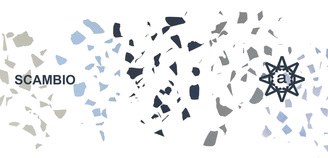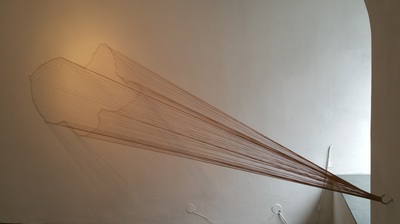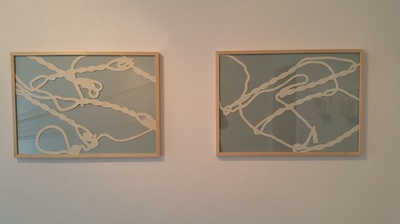By Letizia Romanini

Letizia Romanini is most notably a collector – an attentive traveler in regard to everyday life’s little details, and to small objects found in the streets, by and by in her own or another’s workshop.
Other’s remains of work become for her an inspirational source, potential starting points for poetic works of art spreading out into the space or limiting themselves to little personal shapes.
By regarding sublimely her entourage, she draws all her creative energy from the simplicity, to which she breathes new life and confers a certain magic, opposed to the apparent poverty of the used materials. She suggests with her artworks a sketchy, metonymic and profoundly aesthetic counter-reality.
One finds in her work an interest and a clear predilection for textiles, threads and flexible material, giving birth to unanticipated forms in random appearance, though always drawn from everyday life, flowing off observed and reproduced gestures and paths, collected equally as concrete objects. These forms move between an easiness and apparent freedom on the one hand, and an impassible dictatorship of the laws of gravity on the other. Like the “Monticules”, a series of small objects made of baked clay, directly inspired by the snow heaps in the streets of Vilnius, a monstrous piling of blackened snow so nothing allies to the lightness of a snowflake anymore.
Her fondness – or shall we say her obsession – for her collection creates a certain rhythm in her work, a succession also found in her creation process. Imposing strict and rigorous rules, the artist executes repetitive, orchestral and always similar gestures, during hours and hours of work that make her descend into a state of meditation. Whether it is knitting/crocheting a basketball net of 30 meters of threads, setting up and relying thread to 450 nails, folding 1500 paper planes dashed one by one to the wall after having been dipped into paint, her installations often take a tiring performative shape before rising to an aesthetic and almost peaceful work of art.
We constantly find in the work of Letizia Romanini a coming and going between an object and its opposite, between magic and horror, that the daily grind can inspire us. Thusly, her spatial thread installations seem to float in space, picking up and prolonging light beams, but also block the passage, striking the body, dividing and squashing the space.
The exhibition was made in Cooperation with:



















 RSS Feed
RSS Feed
